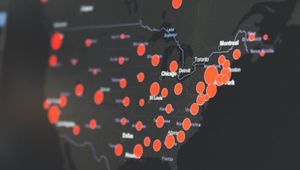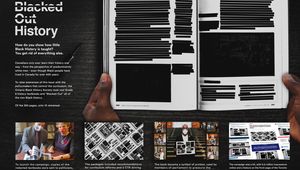
5 Minutes with… Paul Tedesco

For more than 20 years, Paul Tedesco has dedicated himself to following the customer on their journey along the path to purchase and lifelong brand loyalty. As managing director of TrackDDB, Paul is a leading industry practitioner, with vast experience in the CRM and integrated digital space.
TrackDDB is a group of artists and analysts that use personalisation to capture data that creates value. The agency has been experiencing a huge surge in demand as clients get serious about customer experience and using data insights to guide their marketing. A fairly recent client win is JetBlue, on which it is working in partnership with adam&eveDDB.
What’s more, Paul recently celebrated ten years with the DDB agency. LBB’s Addison Capper chatted with him about how CRM and data in advertising have evolved in that time, the ‘always-on’ customer journey, and the importance of understanding data’s limitations as well as its possibilities.
LBB> Congratulations on 10 years with TrackDDB! Thinking back to when you started, how has the world of CRM and data in advertising evolved and changed over that time? I imagine that's a pretty huge question but it feels like a good place to start!
Paul> Whew… you said it, that is a huge question. Ten years ago we were a traditional direct marketing shop. Working mainly with physical direct mail, catalogues and just getting into email. Personalisation meant putting ‘Hi Paul!’ on the piece of work. Innovation in the space was to use actual transactional information to drive a message or offer. This was pretty standard for the time. Today, as more and more channels become addressable, we find ourselves as much more omnichannel and we have formed the bridge between science and creativity to drive connected experiences. Of course, we do email, DM, push, etc., but we now find ourselves using this science (data and technology) to drive relevance across digital channels (display, search, websites, loyalty programs, etc.) and even some more traditional ones such as TV, billboards and radio.
LBB> What’s the number one question that clients are coming to you with when it comes to how they can better use data to enhance the creativity of their content and experiences? And how has that question also evolved over your time with TrackDDB?
Paul> The most common question we get is, ‘Do we have the data we need?’ Most clients believe that there is some mystical source of data that their competitors or peers are using that gives them the edge. This is not reality. Yes, some companies have a wealth of first-party transactional and the resulting behavioural data that gives them a magic bullet, but that is not true of most. Almost all organisations can access data that they can use to make their experiences more relevant and therefore more effective.
For those that have entered the data-driven arena, the most common question seems to be surrounding the changes in our ability to utilise data collected using the third-party cookie. But that is another, much longer, story.
LBB> I read that you believe that “people live in glass houses metaphorically” - can you expand on that for us, please?
Paul> I think I also said in that particular podcast that consumers deserve a fair and righteous exchange for letting you look through the glass.
I think that people are coming to understand just how public their activities are and that much more of their data is available than probably should be. My concern is that people generally don’t know they have (or should have) a choice and they certainly don’t know that they should be being fairly compensated (with value) for their exhibitionism.
LBB> As the years go on, a customer's entire 'journey' with a brand seems to only become more important. How can a company like TrackDDB help its clients and creative agency partners best navigate that journey?
Paul> A customer’s overall experience with the brand is not based on one moment in the journey, it is an aggregation of many moments (some of which we are not even involved in or even see). Technology has enabled us to not only follow a customer’s journey more effectively
but also to understand our customers’ needs at these different moments and match that with relevant experiences and content to help them make more informed decisions. This makes our marketing more effective and efficient.
At Track, we see this journey as one connected, always-on experience. We use data to weed through all of the opportunities to engage to find the ones that are important and meaningful. We then use technology to deliver experiences in those moments that add value to each individual customer.
LBB> In your opinion, how can you make sure that data is elevating creative rather than forming a wind tunnel effect and knocking all the interesting or unique edges off that make something distinctive?
Paul> I think this is a common misconception – that creative and science are at odds. It’s false. In fact, the truth is that they work together. The power of emotional connections and creative that will break through the clutter is still paramount to driving results. Data just ensures that you deliver the right message to the right person at the right time (sorry that was so cliché).
LBB> What are your thoughts about trust in data - to what extent is uncertainty and a lack of trust in data (or data sources) an issue and what are your thoughts on that?
Paul> Data can help us find our customers and understand their needs at different points in the journey. Understanding the potential AND the limitations of data ensures that we leverage it to its best use. We have all heard the stories of when we overfit data and we end up with unwelcome messaging (think Target and pregnancy) or when we miss opportunities that data failed to surface.
LBB> In your view, what’s the biggest misconception people have around the use of data in marketing?
Paul> I would go back to its relationship with creativity. That data is somehow in opposition to creativity. Nothing could be further from the truth.
LBB> How did you wind up in advertising and specifically in the data side of the industry?
Paul> My entry into the marketing world was not planned. Thirty years ago I was running restaurants and was approached by a boutique agency to come on board as an industry expert in food service. To be honest I jumped at the chance for normal hours and stability. I have never looked back. I am a math guy and have always loved data. Being on the B2B side of the business, we did a lot of direct marketing which became CRM… the front lines for data.
LBB> How do you think the world of data in advertising will evolve over the coming 10 years?
Paul> I think there are three things that will drive the future:
- Government intervention… privacy will become an ingrained and protected right.
- Consumer awakening… we will realise that our data is worth dollars.
- Value will become the most important measure in marketing… we will start to think and operate in terms of exchanging value.













